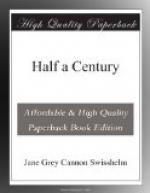Long before I saw an Indian on his native soil, the U.S. Government had spent millions in carrying out this Penn policy. For long years, Indians had sat like crows, watching the white farmers and artisans sent to teach them industry, and had grunted their honest contempt. They watched the potato planting, that they might pick out the seed for present use. They pulled down fences, and turned their ponies into the growing crops, used the rails for fire wood, burned mills and houses built for them, rolled barrels of flour up steep acclivities, started them down and shouted to see them leap and the flour spurt through the staves; knocked the heads out of other barrels, and let the ponies eat the flour; poured bags of corn on the ground when they wanted the bag, and in every way showed their contempt for the government, whose policy they believed to be the result of cowardice. Thousands of dollars’ worth of agricultural machinery lay “rotting in the sun” while the noble red aristocrat played poker in the shade; his original contempt for labor intensified by his power to extract a living from laborers, through their fear of his scalping knife.
Hole-in-the-day, the Chippewa chief, had been educated by Baptist missionaries, and was a good English scholar, but would not condescend to speak to the government except through an interpreter. For him six hundred acres of land had been fenced, and a large frame cottage built and painted white. In this he lived with six wives, and a United States salary of two thousand a year and his traveling expenses. He dressed like a white man, dined with State officers in St. Paul, went to church with a lady on his arm, sat in a front pew, and was a highly distinguished gentleman of the scalping school.
CHAPTER XLIX.
THE INDIAN MASSACRE OF ’62.
The Indians had been ugly from the first outbreak of the Rebellion, and Commissioner Dole, with Senator Wilkinson, had come out to pacify them. The party passed through St. Cloud, and had camped several miles west, when in the night there came up one of those sudden storms peculiar to this land. Their tents were whisked away like autumn leaves, and they left clinging to such productions of mother nature as were at hand, well rooted in her bosom, to avoid a witches’ dance in the air. But it grew worse when the rain had covered the level ground six inches deep in water, and they must keep their heads above the surface.
They returned to St. Cloud in the morning in sorry plight, and the delay was one of the injuries to the poor Indians, and counted as sufficient justification for the subsequent massacre. The delay, however, saved their lives. The messenger who aroused the people of St. Cloud in the small hours was traveling post after this Dole commission, for whose safety there was much anxiety, but none for St. Cloud, since the Indians would not attack us while there were two companies of soldiers in town. True, they were unarmed, but surely arms would be sent and their marching orders rescinded. The outbreak was mysterious. It was of course in the interests of the South, and meant to prevent the troops leaving the State; but why had not the tribes struck together?




